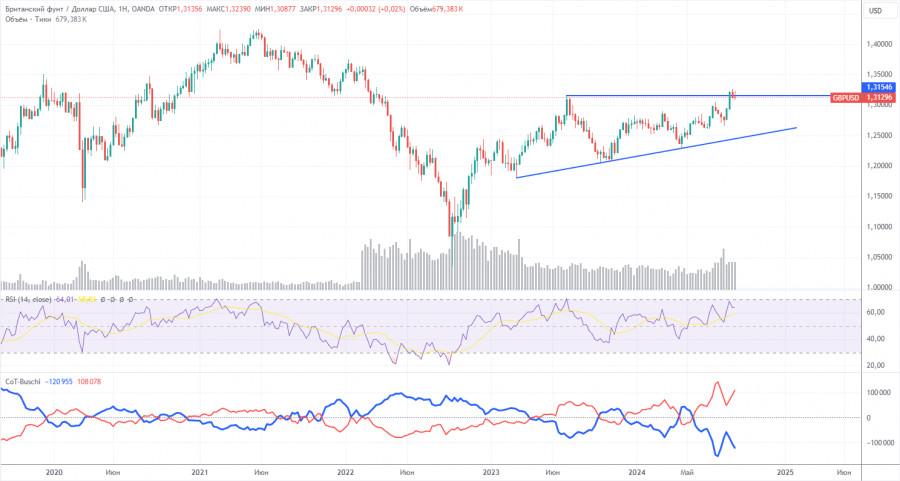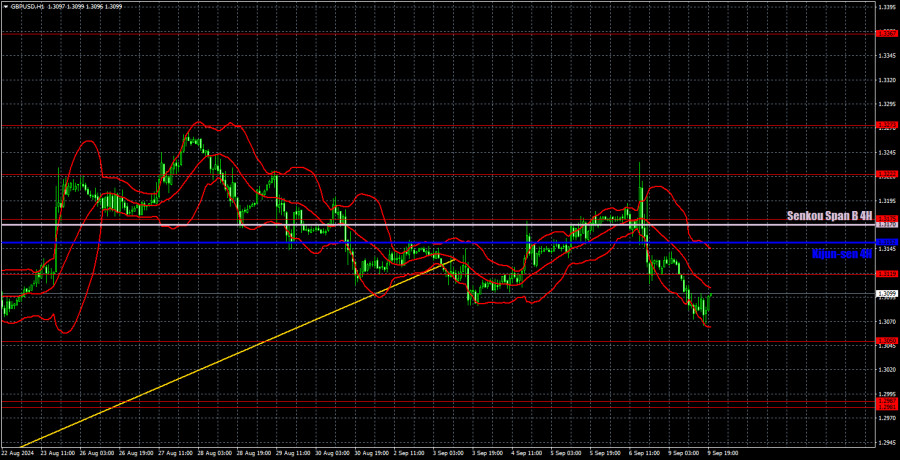

On Monday, the GBP/USD pair traded lower, and the Senkou Span B line moved above the price level. Thus, we also have a downward trend for the pound sterling. However, this trend is extremely weak and uncertain. Despite the trendline being breached, the pair's fall has not yet begun. Since the beginning of the year, we have consistently mentioned that the British pound possesses a truly impressive resistance to falling. In other words, the pound falls much less frequently than the euro, even though the European Central Bank and the Bank of England have been lowering key rates almost in sync and started this process before the Federal Reserve. Also, let's recall that the pound has risen by 600 pips over the last month and now cannot even correct by a third. It seems that the pound only occasionally takes breaks before the next round of the upward movement.
On Monday, there was no macroeconomic data in the US or the UK. The British pound fell slightly but could not drop convincingly below the previous local low. So far, any fall in the British currency looks very uncertain and could end at any moment. And even this week, there will be enough reasons for the market to start a new round of dollar selling. Five somewhat important reports will be released in the UK, and an inflation report will come out in the US. Next week, meetings of the BoE and the Fed will occur, the results of which can easily be interpreted in favor of the pound.
A number of trading signals were formed on Monday, but only the very first one near the level of 1.3119 could be executed. At this point, short positions could have been opened. This was followed by a rebound from the Senkou Span B line, but this signal could have been ignored since the resistance level of 1.3119 remained above. Either the level and line should be considered an area, or wait for a consolidation below the Senkou Span B line to open shorts. Subsequently, the price bounced off the Senkou Span B from below every couple of hours. A short position could be closed at any time.

The COT reports for the British pound show that the sentiment of commercial traders has been subject to frequent changes in recent years. The red and blue lines, representing the net positions of commercial and non-commercial traders, constantly intersect and are mainly close to the zero mark. We also see that the last downward trend occurred when the red line was below zero. Therefore, a downturn could be expected around the level of 1.3154, but this assumption will need regular confirmation over time.
According to the latest report on the British pound, the non-commercial group opened 8,600 buy contracts and closed 9,500 short ones. This led to a significant increase in the net position of non-commercial traders by another 18,100 contracts over the week, and overall, it continues to grow.
The fundamental background still does not provide any grounds for long-term purchases of the pound sterling, and the currency has a real chance to resume the global downtrend. However, an ascending trend line formed in the weekly time frame. Therefore, a long-term decline in the pound is unlikely unless the price breaches this trend line. Despite almost everything, the pound continues to rise. Even when COT reports show that major players are selling the pound, it continues to increase.

In the hourly time frame, GBP/USD continues to correct, but this correction could end at any moment. It may have ended since the price failed to consolidate below the Senkou Span B line, which has settled above the price. Most of the US macroeconomic data last week was weak as usual, which only diminished the market's desire to buy the dollar. The pair corrected, but it has not been able to start a new downtrend.
For September 10, we highlight the following important levels: 1.2605-1.2620, 1.2691-1.2701, 1.2796-1.2816, 1.2863, 1.2981-1.2987, 1.3050, 1.3119, 1.3175, 1.3222, 1.3273, 1.3367. The Senkou Span B (1.3170) and Kijun-sen (1.3152) lines can also serve as sources of signals. Setting the Stop Loss to break even when the price moves in the intended direction by 20 pips is recommended. The Ichimoku indicator lines may shift during the day, which should be considered when determining trading signals.
On Tuesday, the UK is scheduled to release reports on wages, the unemployment rate, and changes in the number of unemployed. These reports might provoke a market reaction, but likely not a very strong one. In the US, nothing is planned.
Support and resistance levels: Thick red lines near which the trend may end.
Kijun-sen and Senkou Span B lines: These Ichimoku indicator lines, transferred from the 4-hour timeframe to the hourly chart, are strong lines.
Extreme levels: Thin red lines from which the price previously bounced. These provide trading signals.
Yellow lines: Trend lines, trend channels, and other technical patterns.
Indicator 1 on COT charts: The net position size for each category of traders.